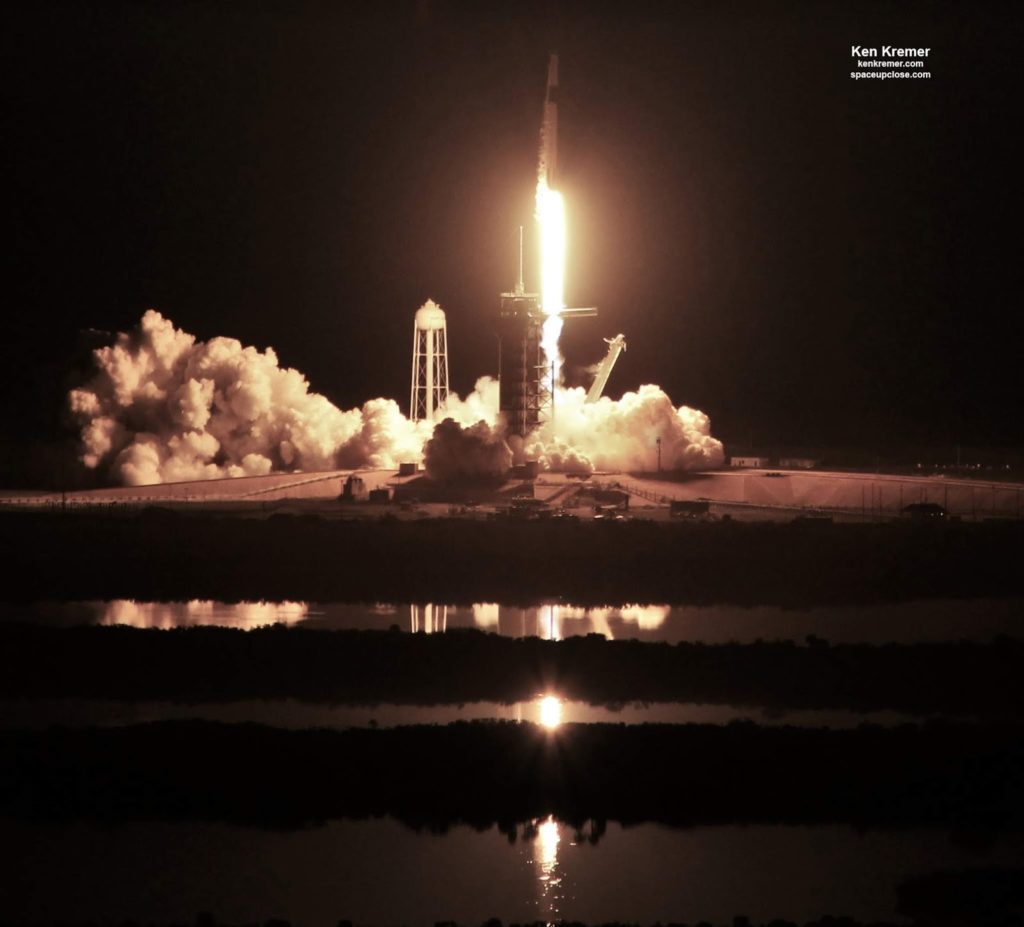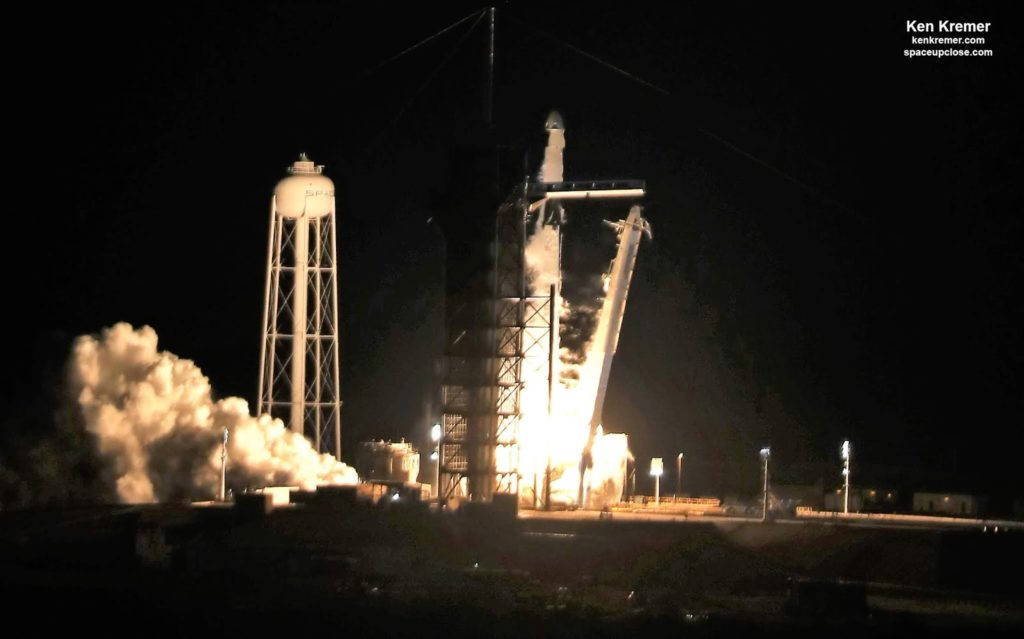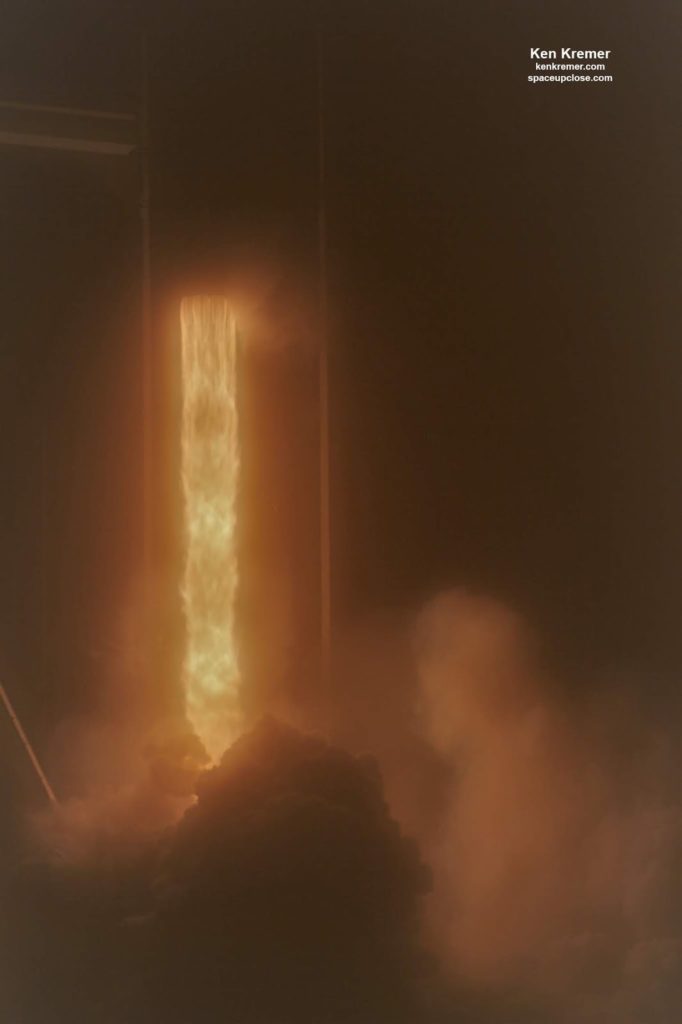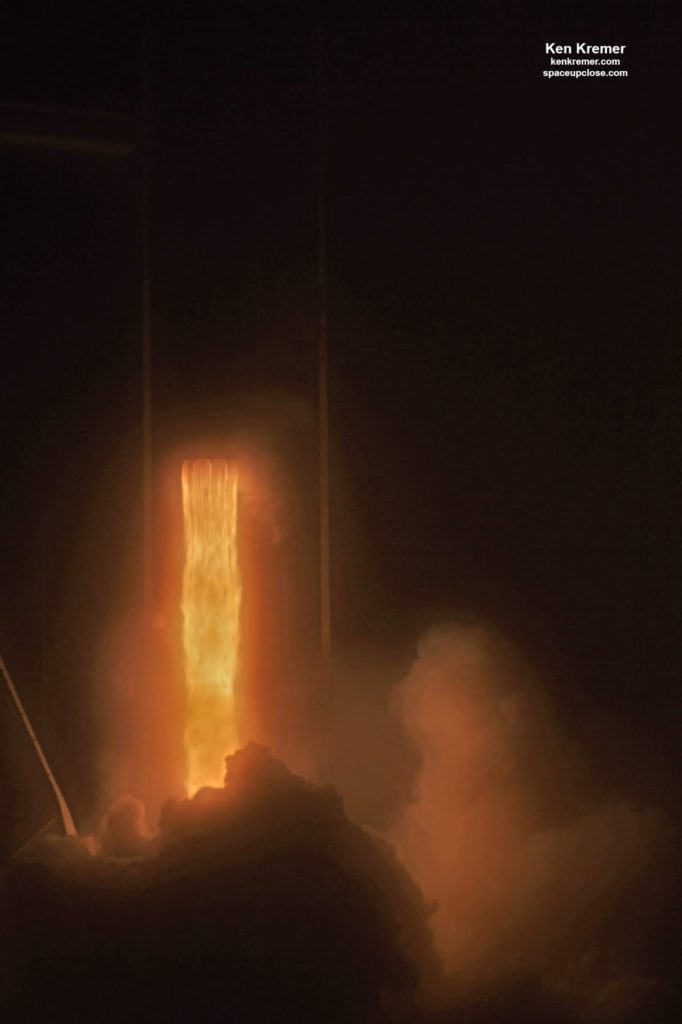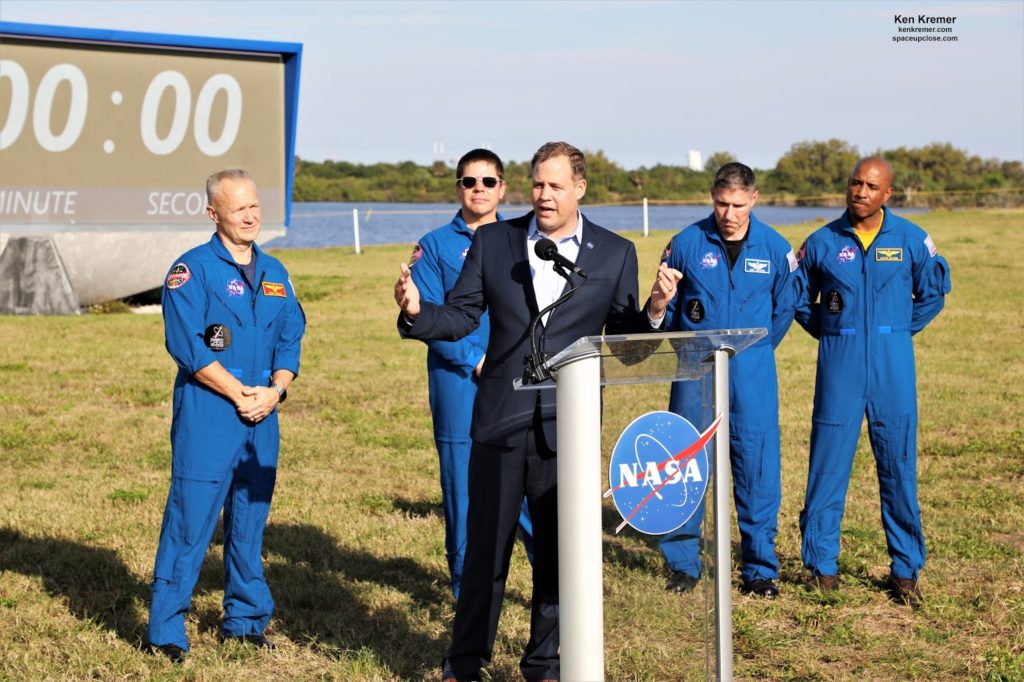Ken Kremer — SpaceUpClose.com & RocketSTEM – 2 March
2019
KENNEDY SPACE CENTER, FL – A truly transformational new era in spaceflight
opened in spectacular fashion early this morning, Saturday, March 2, with the
stunningly beautiful blastoff of the first ever privately built SpaceX Crew
Dragon spacecraft funded by NASA that will soon carry our astronauts back to the
High Frontier for the first time since the premature retirement of the Space
Shuttle program nearly eight years ago.
The Crew Dragon liftoff was flawless and put
on a dazzling sky show for the many thousands of spectators and tourists who
flocked to the Florida Space Coast to witness history in the making.
SpaceX’s Crew Dragon lifted off on its maiden
test flight dubbed Demo-1 atop a SpaceX Falcon 9 rocket at 2:49 a.m. EST (0749 GMT) Saturday from historic Launch Complex-39A at NASA’s Kennedy Space
Center in Florida. That moment coincides with the time when Earth’s rotation carries the rocket into the plane
of the space station to enable a successful rendezvous and docking with the
fuel on board.
Crew Dragon thus began a six day orbital mission
on a ferry flight bound for the International Space Station (ISS) and back.
on a ferry flight bound for the International Space Station (ISS) and back.
The event was transformational because for
the first time in the Space Age private companies – not NASA – are responsible
for designing, testing, manufacturing and launching human rated space ships.
Boeing is building a competing capsule dubbed
Starliner also under contract to and with funding from NASA to ferry American
and partner astronauts to Low Earth Orbit (LEO and the ISS and safely back home.
NASA heralded the Crew Dragon launch as a history
making event – because for the “first time in history, a commercially built and operated
American crew spacecraft and rocket, which launched from American soil, is on
its way to the International
Space Station.”
“Today’s successful launch marks a new chapter
in American excellence, getting us closer to once again flying American astronauts
on American rockets from American soil,” said NASA Administrator Jim
Bridenstine, at the post launch media briefing at the Kennedy Space Center.
“I proudly congratulate the SpaceX and NASA
teams for this major milestone in our nation’s space history. This first launch
of a space system designed for humans, and built and operated by a commercial
company through a public-private partnership, is a revolutionary step on our
path to get humans to the Moon, Mars and beyond.”
Enjoy our Space UpClose eyewitness galley of
imagery as I witnessed the magnificent launch event from the roof the NASA’s
iconic VAB or Vehicle Assembly Building- where all of NASA Saturn Apollo Moon
Rockets and Space Shuttle orbiters were assembled for launch by dedicated and
proud teams for the six decades of the Space Age.
and four grid fins successfully soft landed on the “Of
Course I Still Love You” drone ship (OCISLY) drone ship
at sea in the Atlantic Ocean about 9.5 minutes after liftoff.
SpaceX team. It has been 17 years to get to this point, 2002 to now, and
an incredible amount of hard work and sacrifice from a lot of people that got
us to this point…I’d also like to express great appreciation for NASA,” said
Elon Musk, CEO and lead designer at SpaceX.
the incredible work that was done before SpaceX even started and without the
support after SpaceX did start.”
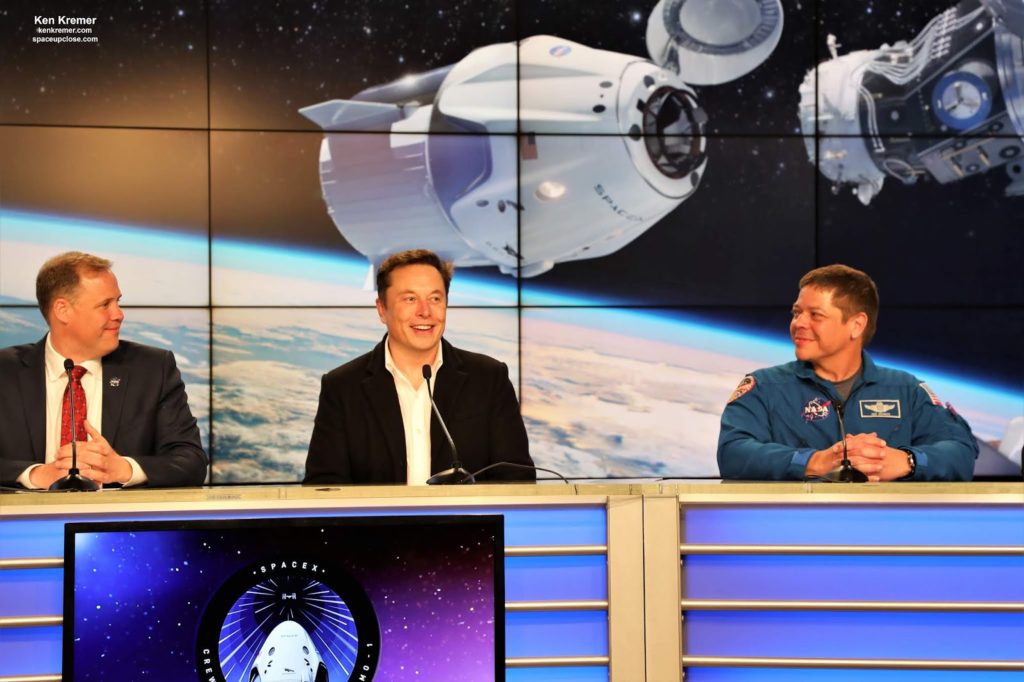 |
|
Elated Elon Musk, SpaceX CEO after successful Demo-1 launch 2:49 AM on Falcon
9 rocket historic from Launch Complex 39A – flanked by elated NASA Administrator Jim Bridenstine and NASA Demo-2 mission Astronaut Bob Behnken at post launch briefing at NASA’s Kennedy Space Center Press Site. Credit: Ken Kremer/kenkremer.com/spaceupclose.com |
Here are the Mission Objectives as Outlined
in detail by NASA:
All the launch pad and vehicle hardware, and the
launch day operations, were conducted in preparation for the next flight with
crew aboard, including the control teams and ground crews. The mission and
testing continues once the Falcon 9 lifts off the pad.
During the spacecraft’s approach, in-orbit
demonstrations will include rendezvous activities from a distance of up to 2.5
miles (4 kilometers), known as far field, and activities within one mile (1.6
kilometers), known as near field. As the spacecraft approaches the space
station, it will demonstrate its automated control and maneuvering capabilities
by reversing course and backing away from the station before the final docking
sequence.
recovery of Crew Dragon, include many first-time events that cannot be totally
modeled on the ground and, thus, are critical to understanding the design and
systems ability to support crew flights. Previous cargo Dragon vehicles have
been attached to the space station after capture by the station’s robotic arm.
The Crew Dragon will approach to dock using new sensor systems, new propulsion
systems and the new international docking mechanism to attach to the station’s
Harmony module forward port, fitted with a new international docking
adapter. Astronauts installed the adapter during a spacewalk in
August 2016, following its delivery to the station in the trunk of a SpaceX
Dragon spacecraft on its ninth commercial resupply services
mission.
400 pounds of crew supplies and equipment to the space station and will return
some critical research samples to Earth. A lifelike test device named
Ripley also will travel on the Crew Dragon, outfitted with sensors to provide
data on potential effects on humans traveling in Crew Dragon.
able to launch as many as four crew members and carry more than 220 pounds of
cargo, enabling the expansion of the crew members, increasing the time
dedicated to research in
the unique microgravity environment, and returning more science back to Earth.
station for up to 210 days, although the Crew Dragon used for this flight test
will not have that capability. This spacecraft will remain docked to the space
station only five days, departing Friday, March 8. After undocking from the
station, Crew Dragon will begin its descent to Earth. Live coverage of the
undocking will air on NASA Television and the agency’s website beginning at 2 a.m., with
deorbit and landing coverage resuming at 7:30 a.m.
a safe departure from the station, followed by a deorbit burn and parachute
deployment to slow the spacecraft before splashdown in the Atlantic Ocean, off
the Florida Space Coast. SpaceX’s recovery ship, Go Searcher, will retrieve
Crew Dragon and transport it back to port. Teams will be closely monitoring the
parachute system and entry control system operation, which have been changed
from cargo Dragons to provide higher reliability for crew flights.
with planned upgrades and additional qualification testing, to further prepare
for Demo-2, the crewed flight test that will carry NASA astronauts Bob Behnken and Doug Hurley to
the International Space Station. NASA will validate the performance of SpaceX’s
systems before putting crew on board for the Demo-2 flight, currently targeted
for July.
……
of SpaceX Demo-1 mission at the Kennedy Space Center.
onsite coverage of NASA, SpaceX, ULA, Boeing, Lockheed Martin, Northrop Grumman
and more space and mission reports direct from the Kennedy Space Center, Cape
Canaveral Air Force Station, Florida and Wallops Flight Facility, Virginia.
Planetary science and human spaceflight news: www.kenkremer.com –www.spaceupclose.com – twitter @ken_kremer
– email: ken at kenkremer.com
area, active in outreach and interviewed regularly on TV and radio about space
topics.
Ken’s photos are for sale and he is available for lectures and outreach events
to ISS, NASA missions, ULA Atlas &
Delta launches, SpySats and more at Ken’s upcoming outreach events at Quality Inn Kennedy Space Center,
Titusville, FL, evenings:
launch, SpaceX Falcon 9 Demo-1 and Nusantara Satu launch, Dragon CRS-16 resupply launch to ISS, SpaceX
Falcon GPS 3-01, SpaceX Falcon Heavy & Falcon 9 launches, upcoming SpaceX
Falcon 9 USAF GP3 3-01, NRO & USAF Spysats, SLS, Orion, Boeing and SpaceX
Commercial crew capsules, OSIRIS-Rex, Juno at Jupiter, InSight Mars lander, Curiosity
and Opportunity explore Mars, NH at Pluto, Kuiper Belt and more,” Kennedy Space
Center Quality Inn, Titusville, FL, evenings.
Photos for sale
upcoming talks:
Mars; The Search for Life & A Journey in 3-D.” 7 PM, Lawton C
Johnson Middle School, Summit, NJ. Open to the public. Details upcoming.
Latest results from Mars & Ultima Thule


